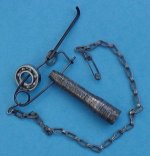- Location
- Rainy side of Washington
I didn't think anyone needed to be told how to use cotter pins, but the last 3 suspension setups I've pulled apart drove me absolutely nuts, so apparently it's not commonly known information. To avoid cursing your past self, here's how you want to put a cotter pin in:

Another acceptable way:

No! noooo! not like that!:

Reason - after a few years, that hole the cotter pin is stuck in is going to be packed full of a combination of rust, road grime, and grease. The end of the pin that is bent out over the end of the shaft will have turned mostly to rust and will be very weak, but the part semi-hidden inside the notch in the castle nut will be at full strength. This makes bending the pin straight again to remove it fairly difficult... and once you have, how do you get it out? The loop on the other end of the pin is inside the notch in the castle nut. Let me tell you, on balljoints and TREs those can be a real party... especially when the blasted thing is so rusty that trying to simply turn the nut and shear the pin off with it results in the TRE ball spinning and many interesting words being applied to it :smsoap:
Not like this either! This is an accident looking for a place to happen!:

Reason - that nut can make about 3-4 full turns before it'll actually get caught and stopped by the cotter pin. Steering is really really floppy and your wheels will be going all over the place by that point. If you put something together and it ends up like this, it means you need a taller castle nut or you reamed the tapers on your knuckles out too deep.
When a cotter pin is inserted properly, the loop won't fit into the notch in the castle nut, and the ends will be splayed out around the castle nut or shaft instead of folded over the end of it. This makes it way easier to straighten back out, and if it's stuck you can grab the splayed ends and saw them in and out to rotate the pin in the hole till it breaks free a bit before straightening it out. Also makes the loop easier to grab. For some reason I see cotter pins put on the right way on almost every dana 30 outer shaft nut, but they're almost always misused on steering and balljoints.
</rant>

Another acceptable way:

No! noooo! not like that!:

Reason - after a few years, that hole the cotter pin is stuck in is going to be packed full of a combination of rust, road grime, and grease. The end of the pin that is bent out over the end of the shaft will have turned mostly to rust and will be very weak, but the part semi-hidden inside the notch in the castle nut will be at full strength. This makes bending the pin straight again to remove it fairly difficult... and once you have, how do you get it out? The loop on the other end of the pin is inside the notch in the castle nut. Let me tell you, on balljoints and TREs those can be a real party... especially when the blasted thing is so rusty that trying to simply turn the nut and shear the pin off with it results in the TRE ball spinning and many interesting words being applied to it :smsoap:
Not like this either! This is an accident looking for a place to happen!:

Reason - that nut can make about 3-4 full turns before it'll actually get caught and stopped by the cotter pin. Steering is really really floppy and your wheels will be going all over the place by that point. If you put something together and it ends up like this, it means you need a taller castle nut or you reamed the tapers on your knuckles out too deep.
When a cotter pin is inserted properly, the loop won't fit into the notch in the castle nut, and the ends will be splayed out around the castle nut or shaft instead of folded over the end of it. This makes it way easier to straighten back out, and if it's stuck you can grab the splayed ends and saw them in and out to rotate the pin in the hole till it breaks free a bit before straightening it out. Also makes the loop easier to grab. For some reason I see cotter pins put on the right way on almost every dana 30 outer shaft nut, but they're almost always misused on steering and balljoints.
</rant>

 an affirmation of something my dad taught me when I was 14...on my '64 Chevy...and I inherited the XJ from him. So indirectly...he got me this far!!
an affirmation of something my dad taught me when I was 14...on my '64 Chevy...and I inherited the XJ from him. So indirectly...he got me this far!!